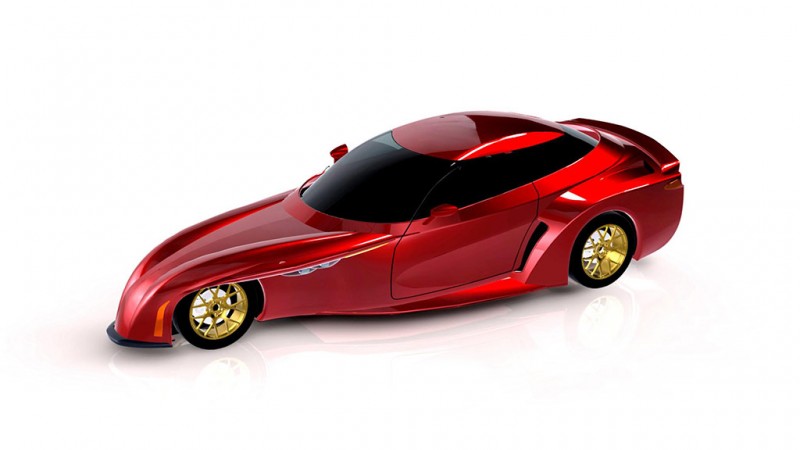DeltaWing Technologies Inc. have revealed how the groundbreaking DeltaWing® architecture – a highly aerodynamic and lightweight design currently competing in IMSA sports car road races in the form of the DeltaWing race car – could look as a street-legal, four-passenger car.
The rendering depicts an exciting, aerodynamic car design that evokes motion, energy and speed even at a standstill and is unlike any of today’s road-going automobiles. And yet the innovative DeltaWing®shape is a true form-follows-function design that can significantly reduce aerodynamic drag to help increase fuel efficiency. Another attribute of the shape is considerably less overall mass. When combined with light-yet-strong materials such as lightweight steel, aluminum and advanced composite materials, the result is a car that can deliver any given performance level with significantly reduced fuel consumption and greenhouse gas emissions compared to conventional automobiles.
Intended as a solution for manufacturers facing more stringent fuel economy and emissions standards, the platform offers efficiency benefits whether using new generation smaller and lighter high efficiency gas or diesel powertrains, alternative fuels like compressed natural gas (CNG), or today’s and tomorrow’s hybrid and all-electric powerplants. DeltaWing Technologies Inc. intends to partner with mass-market auto companies that share its vision rather than manufacture independently, thus offering cars with the DeltaWing® architecture to a broad global audience and significantly expanding the design’s efficiency and environmental benefits.
The narrow-track front wheelbase incorporates smaller width tires. The rear-engine design places the center of gravity far to the rear. That results in significantly less weight on the front axles, reducing rolling resistance and further increasing efficiency. Handling is extraordinarily agile, as proven by the narrow front track of the DeltaWing race car competing on America’s most challenging road courses in the IMSA-sanctioned TUDOR United SportsCar Championship.
Don Panoz, chairman of DeltaWing Technologies Inc. said,
“Many of the aerodynamic, lightweight and handling benefits of the race car can translate to the street. We are competing at the highest levels of road racing with half the weight, half the horsepower, and nearly half of the fuel consumption. We believe we can deliver similar results on the street without compromising safety, comfort and performance. We have a formula that’s highly efficient and still fun to drive.”
Panoz also said the DeltaWing race car proves teams do not have to rely heavily on horsepower to be competitive.
“Design, technology, efficient use of lightweight materials, lower horsepower and lower fuel consumption is a winning formula. I believe this is the future of motorsports, and key to meeting the next decade’s fuel economy and emissions standards.”
Positioned to Help Auto Manufacturers Meet the 2025 54.5 mpg CAFE Requirements
DeltaWing Technologies Inc.’s goal is to advance the future of the automobile by delivering fuel efficient, green technologies that benefit everyday drivers and commuters and reduce oil consumption and greenhouse gas emissions. Company executives have been meeting with auto manufacturers that support the goal of bringing the DeltaWing® vehicle architecture and its lightweight and efficiency technologies to road cars to help meet the CAFE (Corporate Average Fuel Economy) standard of 54.5 mpg by model year 2025.
The four cornerstones of the DeltaWing® approach are reduced weight, increased powertrain efficiency, decreased energy consumption, and improved aerodynamics. DeltaWing Technologies is seeking OEM partners that share its vision, ultimately licensing to automobile manufacturers the DeltaWing® vehicle architecture that is 35 percent lighter, requires 35 percent less horsepower, and consumes 35 percent less fuel. The current performance targets are 0-60 mph in about six seconds, 130 mph top test-track speed, and up to 70 mpg when using a small displacement, four-cylinder engine producing between 85 and 110 horsepower.
“While we certainly have the capabilities and decades of auto manufacturing experience through our affiliates Panoz LLC and Élan Motorsports Technologies, the DeltaWing deserves the higher volume that an OEM can provide to truly have a beneficial impact on the future and the environment,”
said Al Speyer, DeltaWing Technologies president and COO.
Reducing Costs, Retaining Brand Identity, and Streamlining Timelines
DeltaWing Technologies can help OEMs that license its technology design and develop a DeltaWing®road vehicle using their existing components and systems or downsized
components, which can greatly reduce vehicle design and production costs. It also will work closely with each OEM to incorporate their brand styling design requirements and meet their vehicle content needs.
With the typical new car, truck or SUV taking approximately five years to go from concept to production, DeltaWing can spearhead the validation and certification processes and help shorten the timeline to deliver a production-ready prototype. This capability comes from the close interaction among DeltaWing Technologies’ aforementioned automotive and technology affiliates.
The DeltaWing® road car computer-aided design styling and modular platform engineering plans are very far along and at the point where further work would focus on OEM-specific needs. This advance work also greatly contributes to decreasing the production-ready platform development timeline.
Source; DeltaWing Technologies Inc.

